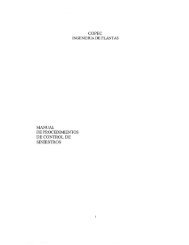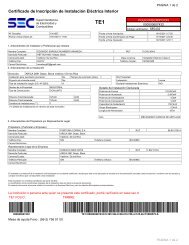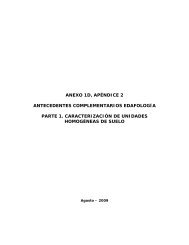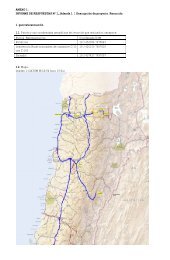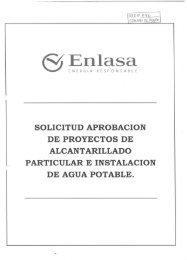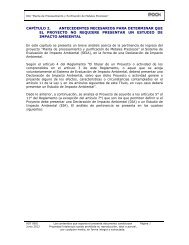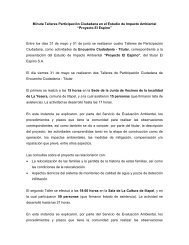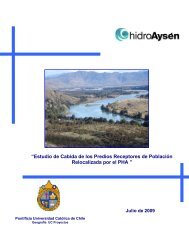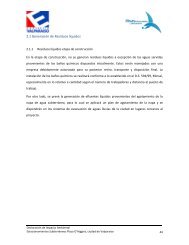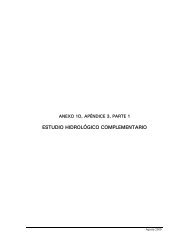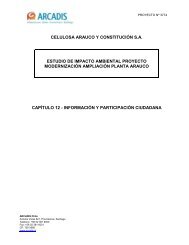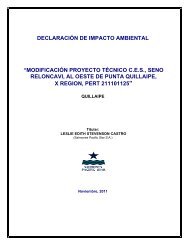- Page 1 and 2:
DECLARACION DE IMPACTO AMBIENTAL
- Page 3 and 4:
El Teniente 1. Objetivos y Alcance
- Page 5 and 6:
El Teniente Gestión de RIS Código
- Page 7 and 8:
El Teniente 3.8 Protección Industr
- Page 9 and 10:
El Teniente Gestión de RIS Código
- Page 11 and 12:
El Teniente 4.5 Destinatario de Res
- Page 13 and 14:
El Teniente Gestión de RIS Código
- Page 15 and 16:
El Teniente Gestión de RIS 1.- Ide
- Page 17 and 18: El Teniente • Letreros para resid
- Page 19 and 20: Código CG El Teniente Maderas SSS-
- Page 21 and 22: El Teniente Gestión de RIS 1.3 Eti
- Page 23 and 24: El Teniente Gestión de RIS 2.2 Dis
- Page 25 and 26: El Teniente Gestión de RIS Código
- Page 27 and 28: El Teniente A.- Peligrosos: Gestió
- Page 29 and 30: El Teniente B.- No Peligrosos Gesti
- Page 31 and 32: El Teniente Gestión de RIS Código
- Page 33 and 34: El Teniente Gestión de RIS Luego,
- Page 35 and 36: El Teniente Gestión de RIS Código
- Page 37 and 38: El Teniente Nombre del Centro Gener
- Page 39 and 40: El Teniente Nombre: Taller Mecánic
- Page 41 and 42: El Teniente Nombre: Taller Mecánic
- Page 43 and 44: El Teniente Gestión de RIS ANEXO N
- Page 45 and 46: Ejemplar Vigente en Biblioteca Elec
- Page 47 and 48: El Teniente ANEXOS Ejemplar Vigente
- Page 49 and 50: Ejemplar Vigente en Biblioteca Elec
- Page 51 and 52: Ejemplar Vigente en Biblioteca Elec
- Page 53 and 54: Ejemplar Vigente en Biblioteca Elec
- Page 55 and 56: Ejemplar Vigente en Biblioteca Elec
- Page 57 and 58: Ejemplar Vigente en Biblioteca Elec
- Page 59 and 60: Ejemplar Vigente en Biblioteca Elec
- Page 61 and 62: Ejemplar Vigente en Biblioteca Elec
- Page 63 and 64: Ejemplar Vigente en Biblioteca Elec
- Page 65 and 66: Ejemplar Vigente en Biblioteca Elec
- Page 67: Ejemplar Vigente en Biblioteca Elec
- Page 71 and 72: CÓDIGO DEL PROCESO Ejemplar Vigent
- Page 73 and 74: CÓDIGO DEL PROCESO CÓDIGO DEL PRO
- Page 75 and 76: CÓDIGO DEL PROCESO Ejemplar Vigent
- Page 77 and 78: CÓDIGO DEL PROCESO CÓDIGO DEL PRO
- Page 79 and 80: Ejemplar Vigente en Biblioteca Elec
- Page 81 and 82: Código Nombre El Teniente PLAN DE
- Page 83 and 84: Código Nombre 1 2 4(1) 4(2) Tambor
- Page 85 and 86: Ejemplar Vigente en Biblioteca Elec
- Page 87 and 88: Ejemplar Vigente en Biblioteca Elec
- Page 89 and 90: El Teniente CODIGO PRACTICA Ejempla
- Page 91 and 92: Ejemplar Vigente en Biblioteca Elec
- Page 93 and 94: Ejemplar Vigente en Biblioteca Elec
- Page 95 and 96: Ejemplar Vigente en Biblioteca Elec
- Page 97 and 98: Ejemplar Vigente en Biblioteca Elec
- Page 99 and 100: Ejemplar Vigente en Biblioteca Elec
- Page 101 and 102: Ejemplar Vigente en Biblioteca Elec
- Page 103 and 104: Ejemplar Vigente en Biblioteca Elec
- Page 105 and 106: Ejemplar Vigente en Biblioteca Elec
- Page 107 and 108: Ejemplar Vigente en Biblioteca Elec
- Page 109 and 110: Ejemplar Vigente en Biblioteca Elec
- Page 111 and 112: Ejemplar Vigente en Biblioteca Elec
- Page 113 and 114: Ejemplar Vigente en Biblioteca Elec
- Page 115 and 116: Ejemplar Vigente en Biblioteca Elec
- Page 117 and 118: Ejemplar Vigente en Biblioteca Elec
- Page 119 and 120:
Ejemplar Vigente en Biblioteca Elec
- Page 121 and 122:
CÓDIGO C2 C3 NOMBRE CURSO (REFEREN
- Page 123 and 124:
Ejemplar Vigente en Biblioteca Elec
- Page 125 and 126:
Ejemplar Vigente en Biblioteca Elec
- Page 127 and 128:
Ejemplar Vigente en Biblioteca Elec
- Page 129 and 130:
Ejemplar Vigente en Biblioteca Elec
- Page 131 and 132:
Ejemplar Vigente en Biblioteca Elec
- Page 133 and 134:
El Teniente PLAN DE MANEJO RESIDUOS
- Page 135 and 136:
El Teniente PLAN DE MANEJO RESIDUOS
- Page 137 and 138:
Ejemplar Vigente en Biblioteca Elec
- Page 139 and 140:
Ejemplar Vigente en Biblioteca Elec
- Page 141 and 142:
Ejemplar Vigente en Biblioteca Elec
- Page 143 and 144:
24 11 N Ejemplar Vigente en Bibliot
- Page 145 and 146:
N Ejemplar Vigente en Biblioteca El
- Page 147 and 148:
N 51 52 Ejemplar Vigente en Bibliot
- Page 149 and 150:
Ejemplar Vigente en Biblioteca Elec
- Page 151 and 152:
N Ejemplar Vigente en Biblioteca El
- Page 153 and 154:
Tambores Metálicos o Plásticos Co
- Page 155 and 156:
Proyectos Servicios y Suministros R
- Page 157 and 158:
Ejemplar Vigente en Biblioteca Elec
- Page 159 and 160:
Ejemplar Vigente en Biblioteca Elec
- Page 161 and 162:
Ejemplar Vigente en Biblioteca Elec
- Page 163 and 164:
N Ejemplar Vigente en Biblioteca El
- Page 165 and 166:
N Ejemplar Vigente en Biblioteca El
- Page 167 and 168:
N Ejemplar Vigente en Biblioteca El
- Page 169 and 170:
N Ejemplar Vigente en Biblioteca El
- Page 171 and 172:
N° Correlativo: 1. Código Centro
- Page 173 and 174:
HDST Nº 3 Sección 1 Ejemplar Vige
- Page 175 and 176:
HDST Nº 16.7 Sección 1 Ejemplar V
- Page 177 and 178:
HDST Nº 5 Sección 1 HOJA DE DATOS
- Page 179 and 180:
HDST Nº 15.16 Sección 1 HOJA DE D
- Page 181 and 182:
HDST Nº 16.1 Sección 1 HOJA DE DA
- Page 183 and 184:
HDST Nº 16.4 Sección 1 HOJA DE DA
- Page 185 and 186:
HDST Nº 16.9 Sección 1 Ejemplar V
- Page 187 and 188:
HDST Nº 16.18 Sección 1 HOJA DE D
- Page 189 and 190:
HDST Nº 16.41 Sección 1 Ejemplar
- Page 191 and 192:
HDST Nº 18.2/4 Sección 1 Ejemplar
- Page 193 and 194:
HDST Nº 16.3 Sección 1 HOJA DE DA
- Page 195 and 196:
HDST Nº 19.1/5/7 Sección 1 Ejempl
- Page 197 and 198:
HDST Nº 4(1) Sección 1 HOJA DE DA
- Page 199 and 200:
HDST Nº 4(2) Sección 1 HOJA DE DA
- Page 201 and 202:
HDST Nº 1/2 Sección 1 Ejemplar Vi
- Page 203 and 204:
HDST Nº 6 Sección 1 Ejemplar Vige
- Page 205 and 206:
HDST Nº 17.1/2/3 Sección 1 Ejempl
- Page 207 and 208:
HDST Nº 8 Sección 1 Ejemplar Vige
- Page 209 and 210:
HDST Nº 13 Sección 1 Ejemplar Vig
- Page 211 and 212:
HDST Nº 11/12.4 Sección 1 Ejempla
- Page 213 and 214:
HDST Nº 23.3 Sección 1 Ejemplar V
- Page 215 and 216:
HDST Nº 25 Sección 1 Ejemplar Vig
- Page 217 and 218:
HDST Nº 19.8 Sección 1 Ejemplar V
- Page 219 and 220:
HDST Nº 21 Sección 1 Ejemplar Vig
- Page 221 and 222:
HDST Nº 16.11 Sección 1 Ejemplar
- Page 223 and 224:
HDST Nº 16.99 (1) Sección 1 Ejemp
- Page 225 and 226:
HDST Nº 16.99 (2) Sección 1 Ejemp
- Page 227 and 228:
HDST Nº 16.99 (3) Sección 1 Ejemp
- Page 229 and 230:
HDST Nº 16.35 Sección 1 HOJA DE D
- Page 231 and 232:
HDST Nº 16.19 Sección 1 Ejemplar
- Page 233 and 234:
HDST Nº 16.46 Sección 1 Ejemplar
- Page 235 and 236:
Nombre : Nº Centro Generador : Rut
- Page 237 and 238:
El Teniente 1. Objetivos y Alcance
- Page 239 and 240:
El Teniente Ejemplar Vigente en Bib
- Page 241 and 242:
El Teniente Ejemplar Vigente en Bib
- Page 243 and 244:
El Teniente Ejemplar Vigente en Bib
- Page 245 and 246:
El Teniente Equipos de Protección
- Page 247 and 248:
El Teniente Ejemplar Vigente en Bib
- Page 249 and 250:
El Teniente Ejemplar Vigente en Bib
- Page 251 and 252:
Ejemplar Vigente en Biblioteca Elec
- Page 253 and 254:
Ejemplar Vigente en Biblioteca Elec
- Page 255 and 256:
Ejemplar Vigente en Biblioteca Elec
- Page 257 and 258:
8. Anexos. Ejemplar Vigente en Bibl
- Page 259 and 260:
Ejemplar Vigente en Biblioteca Elec
- Page 261 and 262:
Rutas y Equipos para el Manejo de R
- Page 263 and 264:
Ejemplar Vigente en Biblioteca Elec
- Page 265 and 266:
Ejemplar Vigente en Biblioteca Elec
- Page 267 and 268:
Ejemplar Vigente en Biblioteca Elec
- Page 269 and 270:
Nombre: Mantención Ferroviaria Tte
- Page 271 and 272:
Rutas y Equipos para el Manejo de R
- Page 273 and 274:
Procedimiento de emergencia para de
- Page 275 and 276:
Ejemplar Vigente en Biblioteca Elec
- Page 277 and 278:
6.- Verificación Registro de activ
- Page 279 and 280:
Rutas y Equipos para el Manejo de R
- Page 281 and 282:
Rutas y Equipos para el Manejo de R
- Page 283 and 284:
Rutas y Equipos para el Manejo de R
- Page 285 and 286:
Ejemplar Vigente en Biblioteca Elec
- Page 287 and 288:
Ejemplar Vigente en Biblioteca Elec
- Page 289 and 290:
Ejemplar Vigente en Biblioteca Elec
- Page 291 and 292:
Nombre: PROCESO RELAVES Nº Centro
- Page 293 and 294:
Rutas y Equipos para el Manejo de R
- Page 295 and 296:
Rutas y Equipos para el Manejo de R
- Page 297 and 298:
Rutas y Equipos para el Manejo de R
- Page 299 and 300:
Rutas y Equipos para el Manejo de R
- Page 301 and 302:
Rutas y Equipos para el Manejo de R
- Page 303 and 304:
Nombre: Planta de Reactivos y Cal N
- Page 305 and 306:
Ejemplar Vigente en Biblioteca Elec
- Page 307 and 308:
Ejemplar Vigente en Biblioteca Elec
- Page 309 and 310:
Ejemplar Vigente en Biblioteca Elec
- Page 311 and 312:
Ejemplar Vigente en Biblioteca Elec
- Page 313 and 314:
Ejemplar Vigente en Biblioteca Elec
- Page 315 and 316:
Ejemplar Vigente en Biblioteca Elec
- Page 317 and 318:
Procedimiento para Control de Susta
- Page 319 and 320:
Ejemplar Vigente en Biblioteca Elec
- Page 321 and 322:
Ejemplar Vigente en Biblioteca Elec
- Page 323 and 324:
Ejemplar Vigente en Biblioteca Elec
- Page 325 and 326:
4.4 Manejo de Residuos Procedimient
- Page 327 and 328:
Ejemplar Vigente en Biblioteca Elec
- Page 329 and 330:
Ejemplar Vigente en Biblioteca Elec
- Page 331 and 332:
Anexo B Ejemplar Vigente en Bibliot
- Page 333 and 334:
C.1 Del Etiquetado Procedimiento pa
- Page 335 and 336:
Anexo E HISTORIAL DE ACTUALIZACIONE
- Page 337 and 338:
GUÍA ESTÁNDARES DE CONTROL DE FAT
- Page 339 and 340:
o manipule sustancias peligrosas, e
- Page 341 and 342:
• Refiérase a Estándar de Contr
- Page 343 and 344:
GUÍA ESTÁNDARES DE CONTROL DE FAT
- Page 345 and 346:
• Es responsabilidad del conducto
- Page 347 and 348:
C. REQUISITOS DE EQUIPOS E INSTALAC
- Page 349 and 350:
C.14 Condiciones ergonómicas de la
- Page 351 and 352:
El Teniente Preparado Por: Luis Con
- Page 353 and 354:
El Teniente Comunicación y Gestió
- Page 355 and 356:
El Teniente 4. Diagrama de Flujo Co
- Page 357 and 358:
El Teniente Comunicación y Gestió
- Page 359 and 360:
El Teniente Comunicación y Gestió
- Page 361 and 362:
El Teniente 5.2 Reporte formal de i
- Page 363 and 364:
El Teniente Comunicación y Gestió
- Page 365 and 366:
El Teniente Comunicación y Gestió



